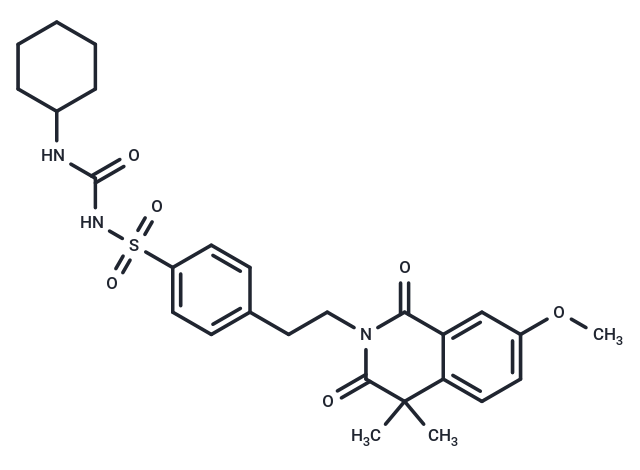Shopping Cart
Remove All Your shopping cart is currently empty
Your shopping cart is currently empty
Gliquidone (AR-DF 26) is a potent, second-generation sulfonylurea with antihyperglycemic activity, exhibiting greater binding affinity to SUR1 and increased potency compared to first-generation compounds. Additionally, this agent exerts peroxisome proliferator-activated receptor (PPAR) gamma agonistic activity.

| Pack Size | Price | USA Warehouse | Global Warehouse | Quantity |
|---|---|---|---|---|
| 25 mg | $35 | In Stock | In Stock | |
| 50 mg | $47 | In Stock | In Stock | |
| 100 mg | $57 | In Stock | In Stock | |
| 500 mg | $138 | - | In Stock | |
| 1 g | $197 | - | In Stock | |
| 1 mL x 10 mM (in DMSO) | $48 | In Stock | In Stock |
| Description | Gliquidone (AR-DF 26) is a potent, second-generation sulfonylurea with antihyperglycemic activity, exhibiting greater binding affinity to SUR1 and increased potency compared to first-generation compounds. Additionally, this agent exerts peroxisome proliferator-activated receptor (PPAR) gamma agonistic activity. |
| Targets&IC50 | K+ channel:27.2 nM |
| In vitro | Intraventricular administration of 0.06–16 μg Gliquidone to each mouse counteracts the antinociceptive effects of tramadol, morphine, and methadone. A dose of 6 μg Gliquidone intraventricularly administered to each mouse inhibits the antinociceptive responses induced by subcutaneous injections of 0.125 mg/kg clonidine and 0.30 mg/kg chlorthalidone; however, a 3 μg dose is ineffective. In male Swiss albino mice, intraventricular injections of 0.1–1.0 μg Gliquidone dose-dependently suppress the antinociceptive effects of amitriptyline and chlorphenamine. In diabetic rats, a 10 mg/kg dose of Gliquidone significantly reduces blood pressure, diminishes non-enzymatic glycation, lowers total protein levels in the lens, and notably increases glutathione levels in the lens. |
| Synonyms | Glurenorm, AR-DF 26 |
| Molecular Weight | 527.63 |
| Formula | C27H33N3O6S |
| Cas No. | 33342-05-1 |
| Smiles | CC1(C)C=2C(C(=O)N(CCC3=CC=C(S(NC(NC4CCCCC4)=O)(=O)=O)C=C3)C1=O)=CC(OC)=CC2 |
| Relative Density. | 1.34 g/cm3 (Predicted) |
| Storage | Powder: -20°C for 3 years | In solvent: -80°C for 1 year | Shipping with blue ice/Shipping at ambient temperature. | ||||||||||||||||||||||||||||||||||||||||
| Solubility Information | DMSO: 97 mg/mL (183.84 mM), Sonication is recommended. Ethanol: 6 mg/mL (11.37 mM), Sonication is recommended. | ||||||||||||||||||||||||||||||||||||||||
| In Vivo Formulation | 10% DMSO+90% Corn Oil: 3.3 mg/mL (6.25 mM), Sonication is recommeded. Please add the solvents sequentially, clarifying the solution as much as possible before adding the next one. Dissolve by heating and/or sonication if necessary. Working solution is recommended to be prepared and used immediately. The formulation provided above is for reference purposes only. In vivo formulations may vary and should be modified based on specific experimental conditions. | ||||||||||||||||||||||||||||||||||||||||
Solution Preparation Table | |||||||||||||||||||||||||||||||||||||||||
Ethanol/DMSO
DMSO
| |||||||||||||||||||||||||||||||||||||||||
| Size | Quantity | Unit Price | Amount | Operation |
|---|

Copyright © 2015-2025 TargetMol Chemicals Inc. All Rights Reserved.